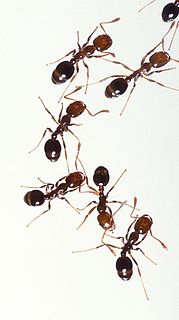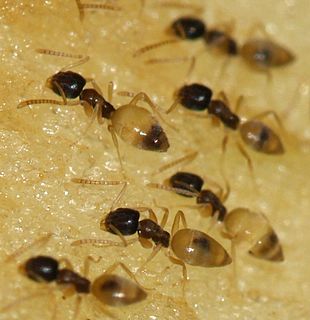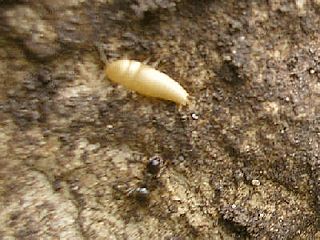
Atta is a genus of New World ants of the subfamily Myrmicinae. It contains at least 17 known species.

Fire ant is the common name for several species of ants in the genus Solenopsis. They are, however, only a minority in the genus, which includes over 200 species of Solenopsis worldwide. Solenopsis are stinging ants and most of their common names reflect this, for example, ginger ants and tropical fire ants. Many species also are called red ants because of their light brown color, though species of ants in many other genera are similarly named for similar reasons. Examples include Myrmica rubra and Pogonomyrmex barbatus.

An instar is a developmental stage of arthropods, such as insects, between each moult (ecdysis), until sexual maturity is reached. Arthropods must shed the exoskeleton in order to grow or assume a new form. Differences between instars can often be seen in altered body proportions, colors, patterns, changes in the number of body segments or head width. After moulting, i.e. shedding their exoskeleton, the juvenile arthropods continue in their life cycle until they either pupate or moult again. The instar period of growth is fixed; however, in some insects, like the salvinia stem-borer moth, the number of instars depends on early larval nutrition. Some arthropods can continue to moult after sexual maturity, but the stages between these subsequent moults are generally not called instars.

Dolichoderinae is a subfamily of ants, which includes species such as the Argentine ant, the erratic ant, the odorous house ant, and the cone ant. The subfamily presents a great diversity of species throughout the world, distributed in different biogeographic regions, from the Palearctic, Nearctic, Afrotropical region and Malaysia, to the Middle East, Australian, and Neotropical regions.

Tapinoma melanocephalum is a species of ant that goes by the common name ghost ant. They are recognised by their dark head and pale or translucent legs and gaster (abdomen). This colouring makes this tiny ant seem even smaller.

Paratrechina is one of seven ant genera in the Prenolepis genus-group from the subfamily Formicinae. Six species are included in Paratrechina; one of which, the longhorn crazy ant, is a widespread, pantropical pest.

Solenopsis molesta is the best known species of Solenopsisthief ants. These ants, which include the majority of species within the genus Solenopsis, get their names from their habit of nesting close to other ant nests, from which they steal food. They are also called grease ants because they are attracted to grease. Nuptial flight in this species occur from late July through early fall.

Trophobiosis is a symbiotic association between organisms where food is obtained or provided. The provider of food in the association is referred to as a trophobiont. The name is derived from the Greek τροφή trophē, meaning "nourishment" and -βίωσις -biosis which is short for the English symbiosis.

Aenictus is a large army ant genus distributed in the Old World tropics and subtropics. It contains about 181 species, making it one of the larger ant genera of the world.

The Argentine ant, formerly Iridomyrmex humilis, is an ant native to northern Argentina, Uruguay, Paraguay, Bolivia and southern Brazil. It is an invasive species that has been established in many Mediterranean climate areas, inadvertently introduced by humans to many places, including South Africa, New Zealand, Japan, Easter Island, Australia, Europe, Hawaii, and the continental United States.

Nicoletiidae is a family of primitive insects belonging to the order Zygentoma. These insects live primarily underground, under detritus, or in caves. A few species are recorded as commensals inside nests of social insects, such as the species Allotrichotriura saevissima which lives inside fire ant nests.

Anochetus is a genus of carnivorous ants found in the tropics and subtropics throughout the world. Only one specie live in South Europa.

Solenopsis saevissima, commonly known in Brazil as formiga de fogo, formiga-vermelha, or formiga-lava-pes, is one of more than 185 species in the genus Solenopsis. It, along with 13 other species, is also a member of the Solenopsis saevissima species group which are popularly known as fire ants.

The longhorn crazy ant, also known as "black crazy ant", is a species of small dark-coloured insect in the family Formicidae. These ants are commonly called "crazy ants" because instead of following straight lines, they dash around erratically. They have a broad distribution, including much of the tropics and subtropics and are also found in buildings in more temperate regions, making them one of the most widespread ant species in the world. This species, as well as all others in the ant subfamily Formicinae, cannot sting.

Linepithema is a genus of small ants in the subfamily Dolichoderinae.

Myrmelachista is a Neotropical genus of ants in the subfamily Formicinae. The genus is found exclusively in the Neotropical region. Little is known regarding their biology.

Melissotarsus is a rare African genus of ants in the subfamily Myrmicinae. They are known from the Afrotropics and Malagasy regions, where their nests are located in living wood, built by tunneling through the wood under the bark. They are rarely seen outside of their nests, which may contribute to their perceived rarity. However, they are considered pest insects because of damage they can cause to trees, including economically important ones such as mangos and trees in the family Burseraceae, including Aucoumea klaineana, Dacryodes buettneri, and Dacryodes edulis.

Nesticodes is a genus of spiders in the family Theridiidae. It was first described in 1950 by Archer. As of 2017, it contains only one species, Nesticodes rufipes, the red house spider.
Camponotus vittatus is a species of carpenter ant and one of the most common ants found around households in South America, particularly Brazil. It was originally described by Auguste Forel in 1904. The species is relatively large, caramel-coloured, omnivorous, and fast-moving. The species presents four larval stages which will spin a cocoon to pupate. The hairs of Camponotus larvae are quite abundant, and may present taxonomic importance. The larvae of both sexes are similar, with few diagnostic traits, such as the acquired shape towards pupation inside their cocoons.
Camponotus textor, also known as Brazilian weaver ant, is a species of fairly common tree-dwelling ant native to South and Central America. It is believed to include a number of cryptic species, and previously were considered synonymous to the cavity-dwelling ant Camponotus senex, now thought to be only distantly-related.

















